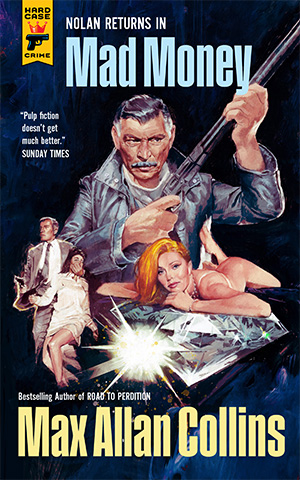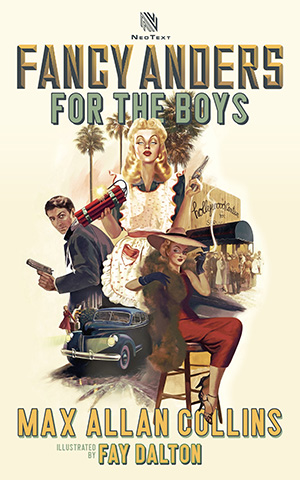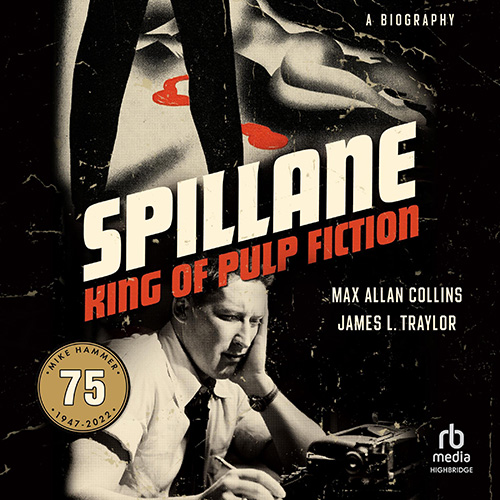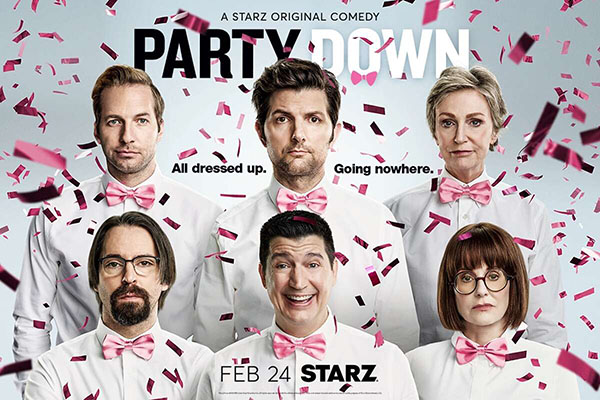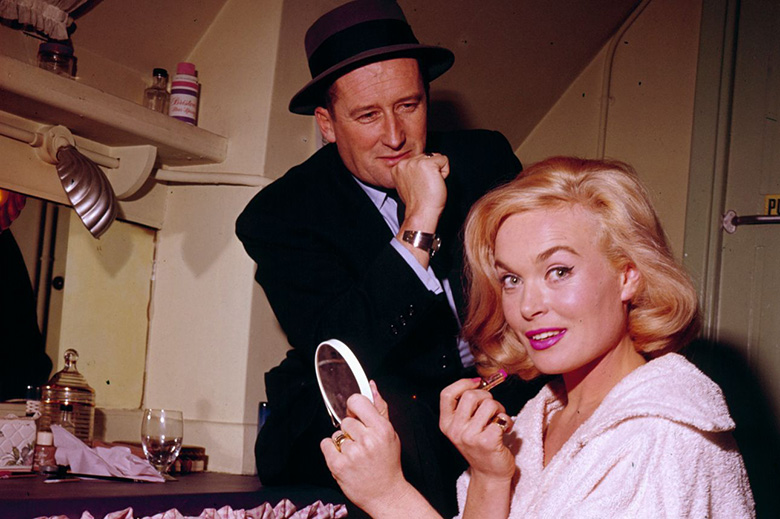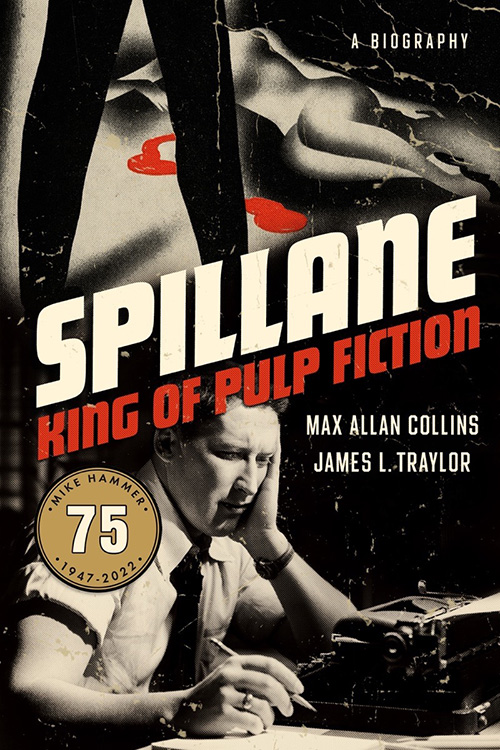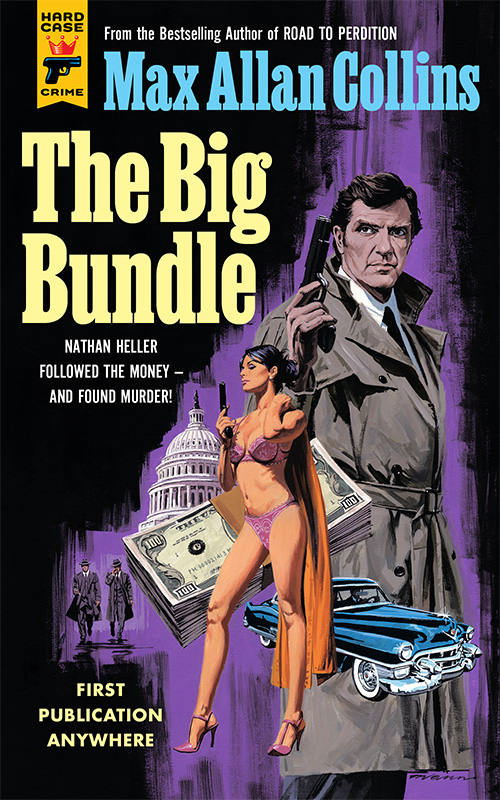We have ten copies to give away of the lovely new Hardcase Crime release, Mad Money, a combo of two Nolan novels, Spree and Mourn the Living. Spree is considered by many the best of the Nolan books, and Mourn the Living – his first appearance, written when I was but a lad of 19 or so – has never appeared as a mainstream paperback before.
We also have ten copies of Fancy Anders For the Boys. This is the second of the three Fancy Anders novellas. Fancy is a private eye working in Hollywood during World War Two; in this novella, she has gone undercover at the Hollywood Canteen on a murder investigation.
[All copies have been claimed! Thank you for your support, and see you next time! –Nate]
This is the last of the Hardcase Crime series of Nolan reprints (plus the new Skim Deep) and they have done an incredible job. Thank you, editor Charles Ardai.
Fancy Anders For the Boys is not available in stores. It was published as an e-book by Neo-Text and this is a (quite nice) Print-on-Demand. The Fay Dalton illos are in color on the e-book, and in black-and-white in the trade paperback.
For those of you within driving distance, here’ a reminder that Mickey Spillane’s Encore for Murder – the filmed version of our live Golden Age Radio production – will be presented this Friday (March 31) at the Muscatine Community College Black Box Theater. See the end of this update for details.
The night before is the Legends event in Muscatine, with Muscatine Community College honoring me. For those desperate for something to do this coming Thursday evening, here’s the details one last time.
If you’re not a superstar, even if you’ve had some successes and are moderately well-known, making a living as a writer of fiction has never been a picnic. Usually you have a choice between finding a day job and taking on work-for-hire that rarely includes royalties, much less artistic fulfillment.
If you’re somewhat up the literary ladder, that day job is going to be as a “creative writing” teacher at a college or university. But I recall vividly that the University of Iowa Writers Workshop – where I matriculated (and you know how painful that is) – turned down Donald E. Westlake’s application to teach there. The current well-intentioned TV series Lucky Hank, with the great Bob Odenkirk, shows what a soulless draining existence that life can be for a real writer.
But you really have only those two choices, unless you can marry a woman of wealth, and that’s the one attribute my wife did not bring along for the ride. The work-for-hire I’ve done means I’ve written several shelves of books that do not generate any income for me in my dotage.
For me the price has been to work hard – to be prolific – and the return has been both positive (I have indeed made a living) and negative (I am not taken seriously – I “crank books out,” you see). As I’ve reported here before, my first agent – of only two in a career that began in the late 1960s – took me on with the caveat that (as a writer of hardboiled fiction) I was “a blacksmith in an automotive age.” What the fuck am I now?
My markets have shrunk as a generation or two find me repellently politically incorrect and later ones are thoughtlessly dying out. I lost a major market apparently because a sarcastic throwaway joke in public was misinterpreted – perhaps humorlessly or worse willfully – as being my actual opinion. My dream job – a being able to complete Mickey Spillane’s unfinished novels – has largely been realized in a world where the Best-Selling Mystery Writer of the Twentieth Century elicits, “Never heard of him,” from a couple of generations.
It’s an uphill battle but (to mix metaphors) I am in the second half of my last act, so it’ll be over soon. All I have to do is hang on and, hopefully, feather my nest and add to my legacy.
Here’s an example of why I characterize the battle as uphill: a recent visit to the Barnes & Noble in Cedar Rapids, Iowa. I have probably done a dozen book signings there (often in tandem with Barb, for our Antiques books) over the years. None during or after the Covid lockdown, but we’re not talking ancient history here. We also shop there probably once a month. This visit, like any writer, I checked my presence on the shelves…specifically, to see if my two recently published books were in stock – Spillane – King of Pulp Fiction (the biography written with James L. Traylor) and The Big Bundle (the new Nathan Heller novel).
Both books have been glowingly and widely reviewed, including starred reviews in Publisher’s Weekly, the top trade magazine in the book field.
Neither was in stock. Spillane was in the system, but hadn’t been ordered. The Big Bundle did not seem to exist. Not in the computer, anyway. In fairness, I have seen copies of both books in other Barnes & Noble stores, including Davenport and Iowa City. But the book buyer at Cedar Rapids did not choose to even enter us in their computer base.
This is disheartening but it is the life of a writer if your name isn’t Stephen King or Harlan Coben. Now plenty of writers who aren’t named King or Coben have books in that Cedar Rapids bookstore. But few of them will be able to maintain that presence and are doomed to day jobs, possibly teaching others on college campuses how to join a profession that will never enable them eat regularly.
This is a problem that has been there throughout my entire career, but it is worse now. It is in part created by publishers and editors who do not nurture their authors, fail to promote them, fail to allow them to build a name and an audience. It is in part created by a lack of bookstores whose staffs are “book people,” who love and hand-sell books. This problem is acerbated by Amazon and other on-line booksellers who offer books cheaper, but who also tend to push a bestseller list that is preordained.
Nothing much can be done about this, but those of you who love books and prize authors can help by spreading the word about what you’ve read and liked (loved) on your blogs and by posting reviews (however brief) on Amazon and other sites.
I am able to keep going because of you. Yes, Don Westlake said, “A cult writer is seven readers short of the writer making a living,” but your support is what has kept me in the game all these years. And when I say, “Thank you,” I mean it from the bottom of my heart…even if I use a cliche to express it.
Not to put too fine a point on it, I hated John Wick 4.
Looking at Rotten Tomatoes, it would appear I’m in the minority. Most reviewers like it, most viewers like it. Even love it. So, once again, I’m out of step and probably just plain wrong.
Certainly the movie is well-made. Visually it is often – even consistently – stunning. The art direction is staggeringly beautiful. The action scenes are mind-bogglingly well-staged. The movie begins with a rousing action scene right out of the gate, capped off by a shock; and the movie has a very satisfying ending, both that of the climax and then another of the movie itself. It owes much to Mickey Spillane but I doubt many of those involved even know who Mickey was. But, like a Spillane novel, the film embraces revenge and harsh violence, begins and ends well…and of course Mickey once said, “Nobody reads a novel to get to the middle.”
And yet I hated it. Was almost glazed-over bored.
Start with Keanu Reeves, whose performance has me scratching my head. Is he a brilliant minimalist screen actor? Or just a charismatic lummox? His dialogue mostly consists of one word – “Yeah” – which he somehow turns into three syllables. He performs his martial arts stunts well, even if co-star Donnie Yen outshines him, and performs the John Woo-style shoot ‘em up stuff admirably. And he is the only actor in the piece (including Yen, who is essentially playing Zatoichi) who doesn’t ham it up.
But the dialogue is terrible – Dick and Jane rewriting the Marquis De Sade. The supporting actors caress the words they speak as if it’s Shakespeare, or maybe it’s that they are being paid ten grand a word, and are savoring that. Certainly Ian McShane and Laurence Fishbourne are almost giddy in their over-the-top performances, as if they can see the coins stacking up with every lousy line. The Asian actors alone seem to find the right tone. Bewilderingly bad is putty-faced Bill Skarsgård, so good as the evil clown in the It movies, coming across here like the young Matthew Broderick playing a James Bond villain.
That may be the best way to watch John Wick 4 – imagine Keanu is playing Ted from the Bill and Ted movies and Skarsgård is Ferris Bueller.
I liked the first John Wick (did they steal the “they shouldn’t have killed my dog?” bit from Hard Cash?). I have no memory of John Wick 2, but I think I liked it well enough. I remember thinking they had at least edged up on going too far with the action scenes in John Wick 3. Now in John Wick 4, the action scenes – well-staged but going on forever – become mind-numbing and uninvolving. This is the fantasy of a school shooter the night before the big day.
John Woo’s heroic bloodshed was wrapped up in a Douglas Sirk-style melodrama. What Mickey had was an avenger with a point to his crusade. John Wick just kills a whole lot of people and then…well, you’re going to see it anyway, aren’t you?
The Max Allan Collins Film Festival (in which throughout my birthday month I subject my wife to my favorite movies) continues with only two entries this time.
10. Phantom of the Paradise. Brian DePalma’s greatest film and a movie that wrestles with Vertigo, Chinatown and Kiss Me Deadly for the top spot in my Favorite Films list. Terry Beatty and I used to go to great lengths to see Phantom in theaters in those pre-VCR days. Hard for me to talk about this one because I love it so much – every actor, not just William Finley and Paul Williams and Jessica Harper, but also Gerrit Graham and George Memmoli and Archie Hahn (and the rest of the Juicy Fruits). I’ve sometimes had difficulty convincing people who dismiss Williams as an easy listening artist (which at times he was, but a brilliant one) that his score is the definitive rock opera. A unique blend of horror and satire, Phantom is a movie unlike any other even as it invokes everything from Psycho to The Cabinet of Caligari, from The Picture of Dorian Gray to Faust…and, well, The Phantom of the Opera.
11. Vertigo. Why am I as messed up as I am? Is it that I began reading reprints of the most violent era of Dick Tracy when I was six? That my mother read me Tarzan novels by Edgar Rice Burroughs around the same time? Possibly. But also I was ten years old when I first saw Vertigo. You can only see Vertigo for the first time once. But the glory of it is you get to watch it for second time once, as well, and for me anyway that began a series of viewings that always reveal new depths and nuances. Look, it’s an outrageous plot. Like the best of Spillane, it’s a fever dream, but one that poses as a romantic one, when at its tragic heart it’s the story of a detective who can’t stop himself from detecting and a woman who can’t stop pretending to be the woman she (SPOILER ALERT) conspired to help kill. This – like Phantom of the Paradise – works on me every time. Every damn time I get caught up in it. Don’t tell me the story is preposterous because I don’t care. It’s melodrama, which is pretty much the only kind of story I am interested in and that moves me. It’s easy to get caught up in Stewart’s performance, which begins with him as his genial screen self and gradually, then dramatically, devolves into a dangerous obsessive. Instead, next time you watch it, take your eyes off Stewart and pay attention to how layered Novak’s performance is.
Here’s an article on Irish comic book characters, and Michael O’Sullivan of Road to Perdition is in first place!
Here is a positive and even erudite review of Spillane – King of Pulp Fiction.
Another positive Spillane bio review is here (after the Harper Lee one!).
Film Premiere Press Release
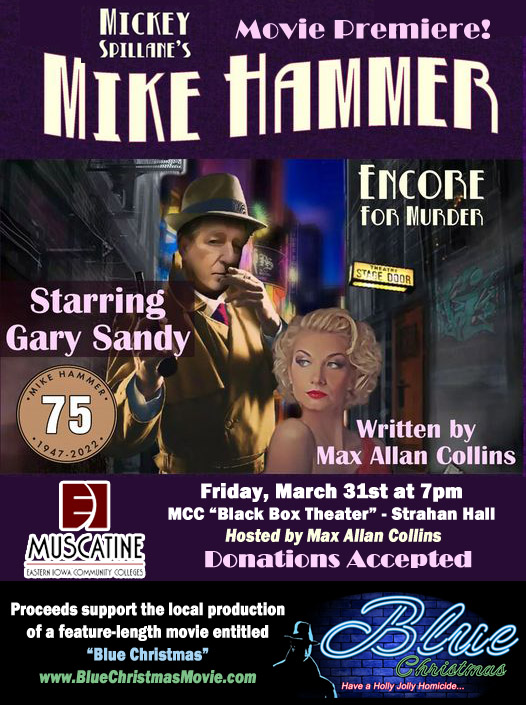
Mickey Spillane’s Encore for Murder was professionally shot during its one-time-only stage performance in Sept 2022. Premiere of the film is Friday, March 31, 2023 at 7:00 pm at Muscatine Community College Black Box Theatre in Muscatine, Iowa. Admittance is free. Collins wrote the graphic novel Road to Perdition on which the Academy Award-winning film was based, as well as the New York Times best-selling novel version of Saving Private Ryan. His Quarry mystery novels became a recent HBO Cinemax series and he has continued the famous Mike Hammer PI series working from the late author’s unfinished materials. Encore for Murder will be included on an upcoming Blu-ray release from VCI Home Entertainment as a bonus film with Collins’ documentary, Mike Hammer’s Mickey Spillane. Spillane is widely considered the “king of pulp fiction” and became America’s best-selling post-WW II writer. The audience at the March 31 screening will be the first to see and hear about the newest venture Blue Christmas, written and directed by Collins and shot entirely in Muscatine, working with editor Chad Bishop and director of photography Phillip W. Dingeldein of dphilms in the Quad Cities. Collins and Dingeldein worked together on the Muscatine-lensed film Mommy (seen on Lifetime TV).
Encore for Murder was originally produced as a Fundraiser for the Muscatine Art Center. Actor Gary Sandy of WKRP in Cincinnati fame, who appeared as Mike Hammer in productions of Encore for Murder in Kentucky and Florida, reprised his acclaimed performance in the Iowa production. Dingeldein and Chad Bishop filmed the event, staged as a Golden Age of Radio production with scripts in hand but in costume, with an on-stage sound effects table, music and a big screen presentation of scene-setting slides.
Audience Q & A will be available after the film and news about Blue Christmas.
M.A.C.
